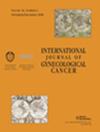摘要
研究目的本研究旨在描述两种类型的子宫内膜异位症相关卵巢癌:具有过渡元素(非典型子宫内膜异位症和边缘性肿瘤)的卵巢癌与与子宫内膜异位症无关的卵巢癌病例:这是一项前瞻性、观察性、单中心研究,研究时间为2021年11月至2023年12月。根据是否存在子宫内膜异位症和过渡性病变,将符合手术条件的卵巢癌患者分为与子宫内膜异位症相关的卵巢癌组、子宫内膜异位症偶发的卵巢癌组和无子宫内膜异位症的卵巢癌组。记录了临床、声像图、手术和病理数据以及无进展生存期。根据手术前变量建立逻辑回归模型,对患者进行准确分类:在纳入的 170 名患者中,83 人(48.82%)患有无子宫内膜异位症的卵巢癌,39 人(22.94%)患有子宫内膜异位症偶发卵巢癌,48 人(28.24%)患有子宫内膜异位症相关卵巢癌。与无子宫内膜异位症的卵巢癌患者相比,子宫内膜异位症-偶发卵巢癌和子宫内膜异位症相关卵巢癌患者的确诊年龄较小(p = .002),绝经后发病率较低(p = .011)。与无子宫内膜异位症的卵巢癌患者相比,与子宫内膜异位症相关的卵巢癌患者妊娠次数较少(p < .001),CA-19.9水平较高(p = .002),出现单侧和多发实变性病灶(p < .001)。子宫内膜异位症合并卵巢癌患者的病灶形态介于两者之间。与子宫内膜异位症偶发卵巢癌和无子宫内膜异位症卵巢癌相比,子宫内膜异位症相关卵巢癌大多在妇产科联盟早期(范围:I-II)确诊(p < .001),病变范围较小(p < .001),完全细胞减灭术的可能性较高(p = .035)。与子宫内膜异位症相关的卵巢癌更可能包括透明细胞癌、类子宫内膜癌和间质样腺癌,而其他组别则以浆液组织型为主(p < .001)。逻辑回归模型能准确识别子宫内膜异位症相关卵巢癌患者与子宫内膜异位症偶发卵巢癌患者(曲线下面积 [AUC] = 0.926)和无子宫内膜异位症卵巢癌患者(AUC = 0.968),但不能可靠地区分子宫内膜异位症偶发卵巢癌与无子宫内膜异位症卵巢癌(AUC = 0.668)。子宫内膜异位症偶发卵巢癌的2年无进展生存率为91%,与子宫内膜异位症相关的卵巢癌为80%,无子宫内膜异位症的卵巢癌为59%(P = .024):我们的研究表明,与子宫内膜异位症相关的卵巢癌由两个临床实体组成,子宫内膜异位症偶发卵巢癌是子宫内膜异位症相关卵巢癌和无子宫内膜异位症卵巢癌之间的桥接组。Objective: This study aimed to describe 2 types of endometriosis-associated ovarian cancer: those with transitional elements (atypical endometriosis and borderline tumors) termed endometriosis-correlated or incidental benign endometriosis vs ovarian cancer cases not associated with endometriosis.
Methods: This was a prospective, observational, monocentric study conducted from November 2021 to December 2023. Patients with ovarian cancer eligible for surgery were enrolled and classified into endometriosis-correlated ovarian carcinoma, endometriosis-incidental ovarian carcinoma, or ovarian carcinoma without endometriosis groups based on the presence or not of endometriosis and transitional lesions. Clinical, sonographic, surgical and pathological data and progression-free survival were recorded. Logistic regression models for accurate patient classification were developed from pre-surgical variables.
Results: Of the 170 patients included, 83 (48.82%) had ovarian carcinoma without endometriosis, 39 (22.94%) had endometriosis-incidental ovarian carcinoma, and 48 (28.24%) had endometriosis-correlated ovarian carcinoma. Patients with endometriosis-incidental ovarian carcinoma and endometriosis-correlated ovarian carcinoma were diagnosed at younger ages (p = .002) and had lower post-menopausal rates than patients with ovarian carcinoma without endometriosis (p = .011). Patients with endometriosis-correlated ovarian carcinoma had fewer pregnancies (p < .001) and higher CA-19.9 levels (p = .002) presented with unilateral and multilocular solid lesions than patients with ovarian carcinoma without endometriosis (p < .001). Patients with endometriosis-incidental ovarian carcinoma showed intermediate lesion morphology. Endometriosis-correlated ovarian carcinoma was mostly diagnosed at early Federation of Gynecology and Obstetrics stages (range; I-II) compared with endometriosis-incidental ovarian carcinoma and ovarian carcinoma without endometriosis (p < .001), had less extensive disease (p < .001), and a higher likelihood of complete cytoreduction (p = .035). Endometriosis-correlated ovarian carcinoma was more likely to include clear cell, endometrioid, and mesonephric-like adenocarcinomas, whereas serous histotype predominated in the other groups (p < .001). Logistic regression models accurately identified patients with endometriosis-correlated ovarian carcinoma vs patients with endometriosis-incidental ovarian carcinoma (area under the curve [AUC] = 0.926) and ovarian carcinoma without endometriosis (AUC = 0.968) but could not reliably differentiate endometriosis-incidental ovarian carcinoma from ovarian carcinoma without endometriosis (AUC = 0.668). The 2-year progression-free survival rates were 91% in endometriosis-incidental ovarian carcinoma, 80% in endometriosis-correlated ovarian carcinoma, and 59% in ovarian carcinoma without endometriosis (p = .024).
Conclusions: Our study indicates that ovarian cancer associated with endometriosis consists of 2 clinical entities, with endometriosis-incidental ovarian carcinoma emerging as a bridging group between endometriosis-correlated ovarian carcinoma and ovarian carcinoma without endometriosis.

 求助内容:
求助内容: 应助结果提醒方式:
应助结果提醒方式:


